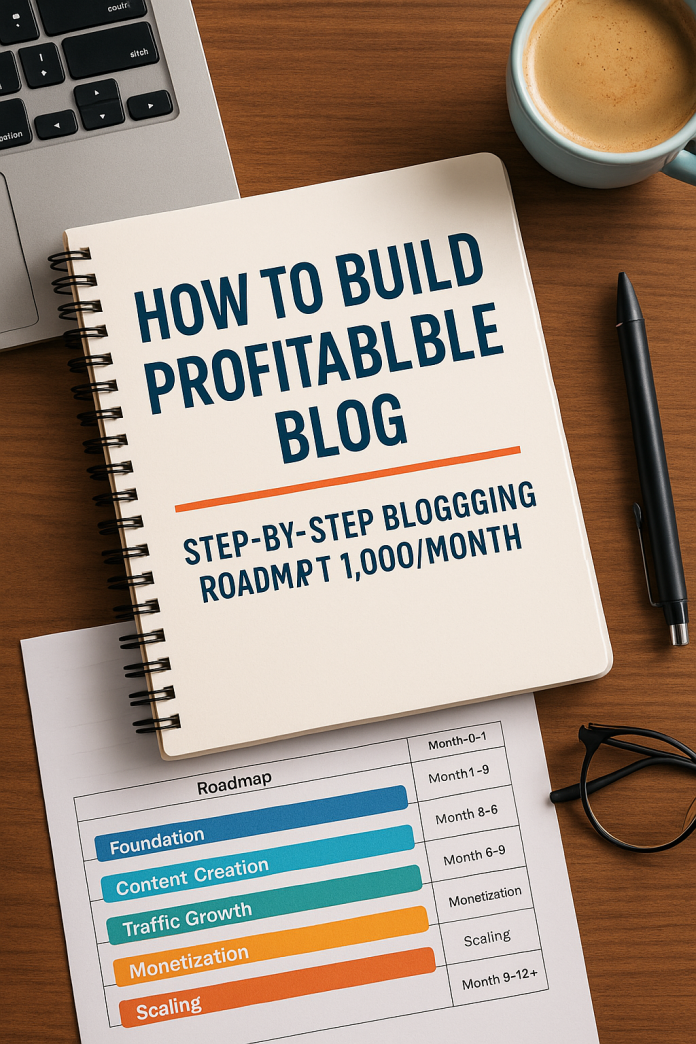Starting a blog is exciting, but turning it into a money-making machine takes strategy, consistency, and patience. In this post, I’ll walk you through a complete blogging roadmap that can bring you from zero traffic and zero income to about $1,000/month. Use this as your playbook, and I’ll also share crucial SEO tips so your blog gets found by readers (and Google).
Why You Need a Roadmap
Without direction, blogging efforts can feel scattered. A roadmap helps you:
-
Stay focused and disciplined
-
Track progress and pivot when needed
-
Avoid costly mistakes others make
-
Grow sustainably (not just short bursts)
Plus, when you build with SEO in mind from the start, your blog can generate organic traffic rather than relying solely on paid promotion.
The 5 Phases of the Blogging Roadmap
Here’s the big picture, then I’ll dive into month-by-month tactics:
| Phase | Timeframe | Focus |
|---|---|---|
| Foundation | Month 0–1 | Setup, niche, SEO basics |
| Content Creation | Month 1–3 | Publishing quality posts |
| Traffic Growth | Month 3–6 | SEO, social, email |
| Monetization | Month 6–9 | Ads, affiliates, deals |
| Scaling | Month 9–12+ | Optimize, grow, diversify |
Phase 1: Foundation (Month 0–1)
Choose Your Niche & Audience
-
Pick something you’re passionate about and that has monetization potential (health, finance, tech, parenting, travel, etc.).
-
Define your ideal reader: their problems, questions, desires.
Blog Setup
-
Use self-hosted WordPress (gives you full control).
-
Get a custom domain + quality hosting.
-
Pick a clean, responsive theme (mobile friendly).
-
Add essential pages: About, Contact, Privacy Policy.
Basic SEO Setup
-
Install an SEO plugin like Yoast SEO, Rank Math, or All in One SEO.
-
Submit your sitemap to Google Search Console.
-
Link your blog to Google Analytics / GA4.
-
Check robots.txt, site speed, mobile usability.
-
Use the SEO Starter Guide from Google as a reference for foundational best practices. Google for Developers
Phase 2: Content Creation (Month 1–3)
Keyword Research & Topic Planning
-
Use tools like Ubersuggest, Ahrefs, SEMrush, or free ones (Google Keyword Planner, Soovle) to find long-tail keywords with low competition.
-
For each post, identify search intent. What is the user really asking?
-
Build a content calendar (plan 3–6 months ahead with 20–30 post ideas).
Writing High-Quality Content
-
Aim for 1,500–2,500 words where needed (but quality > length).
-
Use headings (H2, H3) for structure.
-
Include internal links (link to your own posts), external authoritative links.
-
Use images, infographics, tables.
-
Write compelling introductions & conclusions that include target keywords.
On-Page SEO Best Practices
-
Place your focus keyword in the title, URL slug, first 100 words, and one subheading.
-
Don’t overuse the keyword (avoid keyword stuffing).
-
Optimize images (alt text, compression).
-
Write a custom meta description that entices clicks.
-
Keep your URLs short, simple, and easy to read. Always include the main keyword so both readers and Google understand what the page is about.
Phase 3: Traffic Growth (Month 3–6)
SEO & Search Traffic
-
Continually optimize old posts (update stats, add content, improve readability).
-
Monitor Google Search Console to see which keywords bring impressions and clicks, then pick posts to improve.
-
Start building backlinks: guest posting, outreach, resource pages.
-
Fill content gaps (topics your competitors cover but you don’t).
Social & Community Promotion
-
Share posts on platforms suited to your niche (Pinterest, LinkedIn, Twitter, Instagram, Facebook groups).
-
Engage in niche forums, comment thoughtfully on blogs, Quora/Reddit with links back to your content.
Email List Building
-
Offer a freebie / lead magnet (checklist, template, mini eBook) to get subscribers.
-
Use tools like Mailchimp, MailerLite, ConvertKit.
-
On new content, encourage email signups and send regular newsletters with your posts.
Phase 4: Monetization (Month 6–9)
Display Ads
-
Once you have consistent traffic (e.g. a few thousand visitors/month), apply for Google AdSense.
-
Later, move to better ad networks (Ezoic, Mediavine, AdThrive) which often pay more, but they have traffic thresholds.
Affiliate Marketing
-
Integrate affiliate links naturally into content (product reviews, “best of” lists, tutorials).
-
Choose affiliate programs relevant to your niche (Amazon Associates, niche-specific ones, ShareASale, CJ, Impact).
-
Disclose affiliate links as required by laws/regulations and good ethics.
Sponsored Posts / Collaborations
-
Once your blog has some reputation, brands may pay you to review or feature their product.
-
Always maintain transparency and align with your audience’s interest.
Digital Products / Services
-
You could create eBooks, courses, templates, consulting, coaching.
-
Start small (a $7 mini-course or template) and test market interest.
Phase 5: Scaling & Optimization (Month 9–12+)
Focus on High ROI Content
-
See which posts bring the most traffic & income.
-
Expand them, spin off related posts, add multimedia (video, infographics).
Improve Site Performance & UX
-
Speed up page load (minify CSS/JS, use caching, optimize images).
-
Make navigation intuitive.
-
Use A/B testing for layouts and ad placements.
Advanced SEO & Authority Building
-
Build more backlinks through outreach, collaborations, content marketing.
-
Use pillar content / topic clusters: one big guide + related subtopics linking to it.
-
Keep monitoring algorithm updates and adapt.
Diversify Income Streams
-
Don’t rely only on ads or only on affiliates. Diversify your income streams with a mix of ad revenue, products, services, and sponsorships.
Example 12-Month Action Plan (Month-by-Month)
Here’s a rough schedule:
Month 1: Niche + blog setup + SEO basics
Month 2: Keyword research + publish 5–10 posts
Month 3: Continue content, set up email list + social presence
Month 4: Start SEO outreach, update old posts, build internal links
Month 5: Promote content, increase posting frequency
Month 6: Apply for AdSense, add affiliate links
Month 7: Optimize high-performing posts, outreach for backlinks
Month 8: Negotiate small sponsorships, test small digital product
Month 9: Apply for better ad networks (if traffic allows)
Month 10: Expand product or course, test pricing, collect feedback
Month 11: Scale content production, outsource where needed
Month 12: Review analytics, double down on winners, push to $1,000/month
SEO Tips to Boost Visibility (So You Get More Free Traffic)
-
Follow basic SEO best practices from Google’s own starter guide. Google for Developers
-
Use long-tail keywords (less competitive) early on.
-
Optimize for user experience (fast load, mobile friendly).
-
Use structured data / schema where it makes sense (articles, reviews).
-
Write content that can earn featured snippets (use lists, definitions, Q&A).
-
Avoid indexing useless pages (tag pages, duplicate content).
-
Monitor and adapt, because SEO is a long-term game, not something that brings instant results.
What It REALLY Takes: Mindset & Consistency
-
Be consistent: treat blogging like a job, not a side whim.
-
Don’t expect overnight success: 6 to 12 months is realistic before meaningful revenue.
-
Be ready to iterate: drop things that don’t work, scale things that do.
-
Always serve your audience first: content quality and trust matter.
Conclusion
This roadmap is your blueprint. Use it, tweak it as you go, and stay persistent. At the end of the day, blogging growth is a marathon, not a sprint. If you stay consistent, provide value, and optimize smartly, you can absolutely hit $1,000/month (and beyond).












